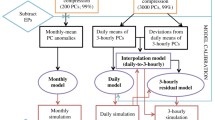Abstract
We present an analysis of the present-day (1961–1990) regional climate simulations over Vietnam. The regional climate model Weather Research and Forecasting (WRF) was driven by the global reanalysis ERA40. The performance of the regional climate model in simulating the observed climate is evaluated with a main focus on precipitation and temperature. The regional climate model was able to reproduce the observed spatial patterns of the climate, although with some biases. The model also performed better in reproducing the extreme precipitation and the interannual variability. Overall, the WRF model was able to simulate the main regional signatures of climate variables, seasonal cycles, and frequency distributions. This study is an evaluation of the present-day climate simulations of a regional climate model at a resolution of 25 km. Given that dynamical downscaling has become common for studying climate change and its impacts, the study highlights that much more improvements in modeling might be necessary to yield realistic simulations of climate at high resolutions before they can be used for impact studies at a local scale. The need for a dense network of observations is also realized as observations at high resolutions are needed when it comes to evaluations and validations of models at sub-regional and local scales.




















Similar content being viewed by others
References
Chen F, Dudhia J (2001) Coupling an advanced land surface–hydrology model with the Penn State–NCAR MM5 modeling system. Part I: model implementation and sensitivity. Mon Weather Rev 129:569–585
Chotamonsak C, JP Salathe, J Kreasuwan, S Chantara and K Siriwitayakorn 2011. Projected climate change over Southeast Asia simulated using a WRF regional climate
Fowler HJ, Ekstrom M, Kilsby CG, Jones PD (2005a) New estimates of future changes in extreme rainfall across the UK using regional climate model integrations—assessment of control climate. J Hydrol 300(1–4):212–233
Frei A, Miller JA, Robinson DA (2003) Improved simulations of snow extent in the second phase of the Atmospheric Model Intercomparison Project (AMIP-2). J Geophys Res 108(D12):4369. doi:10.1029/2002JD003030
Frei C, Scholl R, Fukutome S, Schmidli J, Vidale PL (2006) Future change of precipitation extremes in Europe: intercomparison of scenarios from regional climate models. J Geophys Res 111:D06105. doi:10.1029/2005JD005965
Giorgi F (1990) Simulations of regional climate using a limited area model nested in a general circulation model. J Clim 3(9):941–963
Grell GA (1993) Prognostic evaluation of assumptions used by cumulus parameterizations. Mon Weather Rev 121(3):764–787
Hewitson BC, Crane RG (2006) Consensus between GCM climate change projections with empirical downscaling: precipitation downscaling over South Africa. Int J Climatol 26(10):1315–1337
Hong SY, Pan HL (1996) Nonlocal boundary layer vertical diffusion in a medium-range forecast model. Mon Weather Rev 124(10):2322–2339
IPCC, 2007: Climate change 2007: the physical science basis. Contribution of working group I to the fourth assessment report of the intergovernmental panel on climate change. S Solomon, D Qin, M Manning, Z Chen, M Marquis, KB Averyt, M Tignor and HL Miller, (Eds.) Cambridge University Press, Cambridge, 996 pp
Leung LR, Qian Y, Bian X, Washington WM, Han J, Roads JO (2004) Mid-century ensemble regional climate change scenarios for the western United States. Clim Chang 62(1–3):75–113
Mitchell TD, Jones PD (2005) An improved method of constructing a database of monthly climate observations and associated high-resolution grids. Int J Climatol 25:693–712
New M, Hulme M, Jones PD (1999) Representing twentieth century space-time climate variability. Part 1: development of a 1961-90 mean monthly terrestrial climatology. J Clim 12:829–856
New M, Hulme M, Jones PD (2000) Representing twentieth century space-time climate variability. Part 2: development of 1901-96 monthly grids of terrestrial surface climate. J Clim 13:2217–2238
Phan VT, Thanh ND, Ho TMH (2009) Seasonal and interannual variations of surface climate elements over Vietnam. Clim Res 40:49–60
Schmidli J, Frei C, Vidale PL (2006) Downscaling from GCM precipitation: a benchmark for dynamical and statistical downscaling methods. Int J Climatol 26(5):679–689
Sheridan P, Smith S, Brown A, Vosper S (2010) A simple height-based correction for temperature downscaling in complex terrain. Meteorol Appl 17:329–339
Skamarock WC, Klemp JB, Dudhia J, Gill DO, Baker DM, Duda MG, Hwang XY, Wang W, Powers JG (2008) A description of the advanced research WRF version 3. Technical Note 475+STR. National Centre for Atmospheric Research, Boulder
Takahashi HG, Yoshikane T, Hara M, Yasunari T (2009) High resolution regional climate simulations of the long term decrease in September rainfall over Indochina. Atmos Sci Lett 10:4–18
Takahashi HG, Yoshikane T, Hara M, Yasunari T (2010) High resolution modelling of the impact of land surface conditions on regional climate over Indochina associated with the diurnal precipitation cycle. Int J Climatol 30(13):2004–2020
Thompson G, Rasmussen RM, Manning K (2004) Explicit forecasts of winter precipitation using an improve bulk microphysics scheme. Part-I: description and sensitivity analysis. Mon Weather Rev 132(2):519–542
Uppala SM et al (2005) The ERA40 reanalysis. Q J R Meteorol Soc 131(612):2961–3012
Wang Y et al. (2004) Regional climate modeling: progress, challenges and prospects. J Meteorol Soc Jpn 82:1599–1628
Yatagai A, Kamiguchi K, Arakawa O, Hamada A, Yasutomi N, Kitoh A (2012) APHRODITE: constructing a long-term daily gridded precipitation dataset for Asia based on a dense network of rain gauges. Bull Am Meteorol Soc. doi:10.1175/BAMS-D-11-00122.1
Acknowledgments
The authors profusely thank the anonymous reviewers who have helped us to refine the contents of the manuscript that has improved the quality of the paper.
Author information
Authors and Affiliations
Corresponding author
Rights and permissions
About this article
Cite this article
Raghavan, S.V., Vu, M.T. & Liong, S.Y. Regional climate simulations over Vietnam using the WRF model. Theor Appl Climatol 126, 161–182 (2016). https://doi.org/10.1007/s00704-015-1557-0
Received:
Accepted:
Published:
Issue Date:
DOI: https://doi.org/10.1007/s00704-015-1557-0




